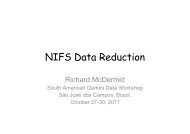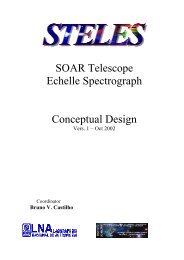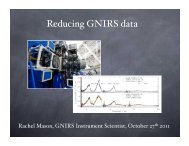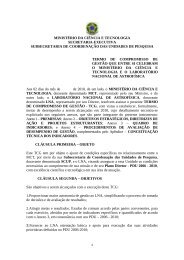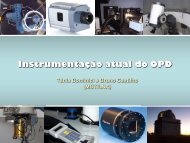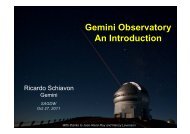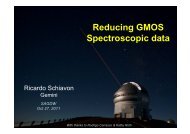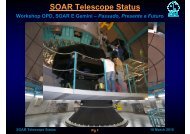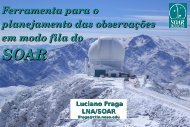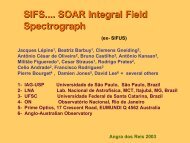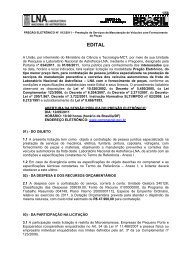RR Lyrae in LMC Globular Clusters: Insights into the Oosterhoff ...
RR Lyrae in LMC Globular Clusters: Insights into the Oosterhoff ...
RR Lyrae in LMC Globular Clusters: Insights into the Oosterhoff ...
Create successful ePaper yourself
Turn your PDF publications into a flip-book with our unique Google optimized e-Paper software.
<strong>RR</strong> <strong>Lyrae</strong> <strong>in</strong> <strong>LMC</strong> <strong>Globular</strong> <strong>Clusters</strong>:<strong>Insights</strong> <strong>in</strong>to <strong>the</strong> <strong>Oosterhoff</strong>Phenomenon and Milky Way FormationCharles KuehnMichigan State UniversityH.A. Smith (MSU)L. Taylor (Transylvania)R.E. McClellan (Ill<strong>in</strong>ois)M. Catelan (PUCC)K. Looper (MSU)B.J. Pritzl (UW-Oskosh)N. DeLee (Florida)K. Dame (MSU)
Galaxy formation mechanisms Cloud collapse Merg<strong>in</strong>gMany observationalevidences of merg<strong>in</strong>g: Sag dSph CMa dSph Substructures <strong>in</strong> <strong>the</strong> M31 halo
MW Inner 100kpc
<strong>RR</strong> <strong>Lyrae</strong>Old Stars (> 10 Gyr)Horizontal branch starsthat lie <strong>in</strong> <strong>the</strong> <strong>in</strong>stabilitystripBurn He <strong>in</strong> coreIntr<strong>in</strong>sically variableRadially pulsate Amplitude’s between 0.1and 1 magnitudesPeriods less than a day(Smith 1995)
Bailey Types Based on shape oflight curve <strong>RR</strong>ab pulsate <strong>in</strong> <strong>the</strong>fundamental mode <strong>RR</strong>c pulsate <strong>in</strong> <strong>the</strong>first overtone <strong>RR</strong>d stars pulsate <strong>in</strong>a comb<strong>in</strong>ation of <strong>the</strong>fundamental mode &<strong>the</strong> first overtone
<strong>Oosterhoff</strong> Groups In 1939 <strong>Oosterhoff</strong>noticed a division <strong>in</strong><strong>the</strong> properties ofglobular cluster <strong>RR</strong><strong>Lyrae</strong>sOOI OOII .55d .65d .32d .37dN <strong>RR</strong>c /N total .17 .44[Fe/H] >-1.7
The <strong>Oosterhoff</strong> dichotomy poses strong constra<strong>in</strong>ts on <strong>the</strong> Galaxy’s early history:Oo-IntermediateMilky WayOo dichotomy <strong>in</strong> fieldKMM test: Galactic distribution is bimodal(“<strong>Oosterhoff</strong> dichotomy”) with P > 99.99%Old halo 2/24Young halo 2/17Bulge/disk 0/02TOTAL 4/439.3%Oo-Intermediate“External”KMM test: s<strong>in</strong>gle-peakeddistribution, withpeak <strong>in</strong> <strong>the</strong> middle of <strong>the</strong> <strong>Oosterhoff</strong> gap!ω Cen 0/01<strong>LMC</strong> GCs 4/12dSph, MCs 8/11For GCs 3/05Sag GCs 2/04CMa GCs 0/03The Galaxy is unlikely to have formed early on by accretion ofprotogalactic fragments resembl<strong>in</strong>g <strong>the</strong> early counterparts of itspresent-day dwarf satellite galaxies.TOTAL 17/3647.2%Catelan 2009, Ap&SS
Field Stars <strong>in</strong> <strong>the</strong> Milky Way Halo The majorityof <strong>the</strong> <strong>RR</strong>abstars fallalong <strong>the</strong><strong>Oosterhoff</strong> Il<strong>in</strong>e.(Courtesy of N. DeLee)
Target Objects 5 <strong>LMC</strong> globular clusters NGC 1466: Oo-Int NGC 1754: Oo-I object NGC 1786: Oo-Int/II object? NGC 2210: Oo-Int object Reticulum: Oo-I 3 of our clusters were also <strong>in</strong>cluded <strong>in</strong> <strong>the</strong> OgleIII Catalog of Variable Stars (Soszyński et al.2009)
ObservationsSmarts - 1.3 m telescopeANDICAMTaken from 10/08/2005 to 12/24/2005 and 09/04/2006 to12/31/2006Average of 130 BVI images for each targetSOAR - 4 m telescopeSOI Taken December 2005, January 2006, and Febuary 2008 61 BVI images for NGC 1754, average of 180 BVI images foro<strong>the</strong>r clustersOGLE – 1.3m telescopeFrom <strong>the</strong> OGLE III Catalog of Variable Stars (Soszyński et al.2009)
NGC 1466 Periods accurate to between 0.00001-0.000030.00003 days [Fe/H]ZW84 = -1.60 +/- 0.05 – from <strong>RR</strong> <strong>Lyrae</strong>sGives an absolute magnitude for <strong>the</strong> <strong>RR</strong> <strong>Lyrae</strong> stars of Mv=0.62+/-0.14 0.14(Catelan & Cortés 2008)Apparent magnitude for <strong>RR</strong> <strong>Lyrae</strong>s: V=19.324+/-0.013 E(B-V)=0.09+/V)=0.09+/-0.020.02 (m-M)0=18.43+/M)0=18.43+/-0.150.15
NGC 1466 [Fe/H]=-1.85 =0.59 days =0.34 days N <strong>RR</strong>c+<strong>RR</strong>d /N total =0.388 All of <strong>the</strong>se suggest an <strong>Oosterhoff</strong><strong>in</strong>termediate classification
NGC 1466
Reticulum
Reticulum Previously searched by Walker (1992)WalkerKuehn<strong>RR</strong> ab 22 22<strong>RR</strong> c 10 9<strong>RR</strong> cand 1 Includes all <strong>RR</strong> <strong>Lyrae</strong> found by Walker Ripepi et al. (2004) found 4 possible <strong>RR</strong>d stars, havenot checked ours yet for double-modes
Reticulum [Fe/H] = -1.66 = 0.552 days = 0.339 days N c /N <strong>RR</strong>L = 0.31 All suggest Reticulum is an <strong>Oosterhoff</strong> Iobject
O<strong>the</strong>r <strong>Clusters</strong>3 clusters <strong>in</strong>cluded <strong>in</strong> <strong>the</strong> OGLE III Catalog of Variable Stars NCG 1754 NGC 1786KuehnOGLE<strong>RR</strong>ab 17 20<strong>RR</strong>c 5 15Many additional candidate <strong>RR</strong> <strong>Lyrae</strong><strong>RR</strong>ab 19 28<strong>RR</strong>c 17 18<strong>RR</strong>d 3 9<strong>RR</strong>cand 10 0 NGC 2210*<strong>RR</strong>ab 33 34<strong>RR</strong>c 14 21<strong>RR</strong>d 4 0* Work done <strong>in</strong> conjunction with Young-Beom Jeon, James M. Nemec, & AlistairR. Walker. Prelim<strong>in</strong>ary results <strong>in</strong> (Jeon et al. 2009)
Fourier Decomposition Lightcurves fit with fourier series Mag = A 0 + ΣA j s<strong>in</strong>(jωt + φ j + Φ) <strong>RR</strong>ab stars are traditionally fit with a s<strong>in</strong>eseries while <strong>RR</strong>c stars are fit with a cos<strong>in</strong>eseries Fourier coefficients give us properties of<strong>the</strong> stars φ ij = jφ i – iφ j R ij = A i /A j
Fourier Fits
Fourier Derived Parameters <strong>RR</strong>c stars Log M/M sun = 0.52 logP – 0.11φ 31 + 0.39 Log L/L sun = 1.04logP – 0.058φ 31 + 2.41 Log T eff = 3.775 – 0.1452logP + 0.0056φ 31 [Fe/H] = 3.702(logP) 2 + 0.124[φ 31 ] 2 – 0.845 φ 311.023 φ 31 logP – 2.620 M v = 1.261 – 0.961P – 0.044 φ 21 -4.447A431 –Equations from Simon & Clement (1993), Morgan, Wahl & Wieckhorst (2007), and Kovács (1998)
Fourier Derived Parameters <strong>RR</strong>ab stars [Fe/H] = -5.038– 5.394P + 1.345φ 31 M v = 1.221 – 1.396P – 0.477A 1 + 0.103φ 31 (V-K)0 = 1.585 + 1.257P -0.273A1 – 0.234φ 31 +0.062φ 41 LogT eff = 3.9291 – 0.1112(V-K)0 -0.0032[Fe/H]Equations from Jurcsik & Kovács (1996), Kovács & Jurcsik (1996), and Jurcsik (1998)
Trends <strong>in</strong> Fourier Parameters vs Cluster Metallicity for <strong>RR</strong>c stars <strong>in</strong> <strong>Globular</strong> <strong>Clusters</strong>. Data from Lázaro et al. (2006), ArellanoFerro et al. (2008), Contreras et al. (2010), Zorotovic et al. (2009), Soszyński et al. (2009), Kuehn et al.(2010).
Trends <strong>in</strong> Fourier Parameters vs Cluster Metallicity for <strong>RR</strong>c stars <strong>in</strong> <strong>Globular</strong> <strong>Clusters</strong>. Data fromLázaro et al. (2006), Arellano Ferro et al. (2008), Contreras et al. (2010), Zorotovicet al. (2009), Soszyński et al. (2009), Kuehn et al. (2010).
Trends <strong>in</strong> Fourier Parameters vs Cluster Metallicity for <strong>RR</strong>c stars <strong>in</strong> <strong>Globular</strong> <strong>Clusters</strong>. Data from Lázaro etal. (2006), Arellano Ferro et al. (2008), Contreras et al. (2010), Zorotovic et al.(2009), Soszyński et al. (2009), Kuehn et al. (2010).
Trends <strong>in</strong> Fourier Parameters vs Cluster Metallicity for <strong>RR</strong>ab stars <strong>in</strong> <strong>Globular</strong> <strong>Clusters</strong>. Data from Lázaro etal. (2006), Arellano Ferro et al. (2008), Contreras et al. (2010), Zorotovic et al.(2009), Soszyński et al. (2009), Kuehn et al. (2010).
Trends <strong>in</strong> Fourier Parameters magnitude vs Cluster Metallicity for <strong>RR</strong>ab stars <strong>in</strong> <strong>Globular</strong> <strong>Clusters</strong>. Data fromLázaro et al. (2006), Arellano Ferro et al. (2008), Contreras et al. (2010), Zorotovic etal. (2009), Soszyński et al. (2009), Kuehn et al. (2010).
Summary The processes that created <strong>the</strong> <strong>RR</strong> <strong>Lyrae</strong>stars <strong>in</strong> <strong>the</strong> OO-Int clusters produce <strong>the</strong>same trends as seen <strong>in</strong> Oo-I/II system butappear to have been cut out <strong>in</strong> <strong>the</strong> MilkyWay.But Are all Oo-Int systems equal?
Are All Oo-Int Systems Equal? Consider <strong>the</strong> case of DracoDraco images and data from K<strong>in</strong>emuchi et al. 2008, AJ, 136, 1921
Are All Oo-Int Systems Equal?Draco images and data from K<strong>in</strong>emuchi et al. 2008, AJ, 136, 1921
ReferencesArellano Ferro, A. et al. 2008, MNRAS 384, 1444Cacciari, C. & Clement<strong>in</strong>i,G. 2003, <strong>in</strong> Stellar Candles for <strong>the</strong> Extragalactic Distance Scale, ed. D. Allo<strong>in</strong>& W. Gieren (Berl<strong>in</strong>: Spr<strong>in</strong>ger), 105Carretta, E. & Gratton, R.J. 1997, A&ASupp 121, 95Catelan, M. 2004, <strong>in</strong> Variable Stars <strong>in</strong> <strong>the</strong> Local Group, Asp Conf. Ser., 310, ed. D.W. Kurtz & K.R.Pollard (San Francisco, Asp), 113Catelan, M. 2009, <strong>in</strong> The Ages of Stars, Proceed<strong>in</strong>gs of <strong>the</strong> International Astronomical Union, IAUSymposium, 258, 209Clement, C.M. & Rowe, J. 2000, AJ 120, 2579Contreras, R. et al. 2010, <strong>in</strong> prepCorw<strong>in</strong>, T.M. et al. 2003, AJ 125, 2543Forbes, D.A. & Bridges, T. 2010, MNRAS 404, 1203Jurcsik, J. & Kovács, G. 1996, A&A 312, 111Kovács, G., 1998, Mem. Soc. Astron. Ital. 69, 49Kovács, G. & Jurcsik, J. 1996, ApJ 466, L17Lázaro, C. et al. 2006, MNRAS 372, 69Morgan, S.M., Wahl, J.N., & Wieckhorst, R.M., 2007 374, 1421Ripepi, V. et al. 2004, CoAST, 145, 24Rutledge, G. et al. 1997, PASP 109, 883Schlegel, D.J., F<strong>in</strong>kbe<strong>in</strong>er, D.P., and Davis, M. 1998, ApJ, 500, 525Simon, N.R. & Clement, C.M., 1993, ApJ 410, 526Soszyński et al. 2009, Acta Astronomica, 59, 1Stetson, P.B. 1994, PASP, 106, 250Walker, A.J. 1992, AJ, 103, 1166Walker, A.J. 1992, AJ, 104, 1395Walker, A.J. 1994, AJ 108, 555Wessel<strong>in</strong>k, A.J. 1971, MNRAS, 152, 159Z<strong>in</strong>n, R. & West, M.J. 1984, APJS 55, 45Zorotovic, M. et al. 2009, arXiv:0911.1686v1



